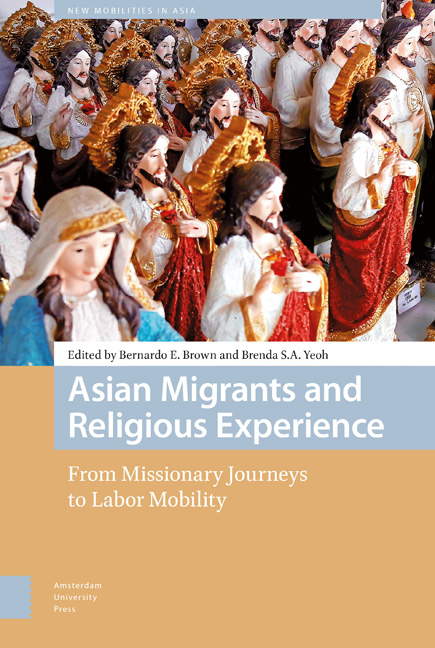Book contents
- Frontmatter
- Contents
- List of Illustrations
- Acknowledgments
- 1 Introduction: Human Mobility as Engine of Religious Change
- Section 1 Mobile Religious Practices
- 2 Saving Yogis: Spiritual Nationalism and the Proselytizing Missions of Global Yoga
- 3 Renewed Flows of Ritual Knowledge and Ritual Affect within Transnational Networks: A Case Study of Three Ritual Events of the Xinghua (Henghua) Communities in Singapore
- 4 Liberalizing the Boundaries: Reconfiguration of Religious Beliefs and Practice amongst Sri Lankan Immigrants in Australia
- Section 2 Transnational Proselytizing
- 5 From Structural Separation to Religious Incorporation: A Case Study of a Transnational Buddhist Group in Shanghai, China
- 6 “10/40 Window”: Naga Missionaries as Spiritual Migrants and the Asian Experience
- 7 Religion, Masculinity, and Transnational Mobility: Migrant Catholic Men and the Politics of Evangelization
- 8 Helping the Wounded as Religious Experience: The Free Burma Rangers in Karen State, Myanmar
- Section 3 Refashioning Religiosity in the Diaspora
- 9 A Multicultural Church: Notes on Sri Lankan Transnational Workers and the Migrant Chaplaincy in Italy
- 10 “Bahala Na Ang Diyos”: The Paradox of Empowerment among Filipino Catholic Migrants in South Korea
- 11 Feeling Hindu: The Devotional Sivaist Esthetic Matrix and the Creation of a Diasporic Hinduism in North Sumatra
- 12 Afterword: What Makes Asian Migrants’ Religious Experience Asian?
- References
- Index
11 - Feeling Hindu: The Devotional Sivaist Esthetic Matrix and the Creation of a Diasporic Hinduism in North Sumatra
Published online by Cambridge University Press: 12 December 2020
- Frontmatter
- Contents
- List of Illustrations
- Acknowledgments
- 1 Introduction: Human Mobility as Engine of Religious Change
- Section 1 Mobile Religious Practices
- 2 Saving Yogis: Spiritual Nationalism and the Proselytizing Missions of Global Yoga
- 3 Renewed Flows of Ritual Knowledge and Ritual Affect within Transnational Networks: A Case Study of Three Ritual Events of the Xinghua (Henghua) Communities in Singapore
- 4 Liberalizing the Boundaries: Reconfiguration of Religious Beliefs and Practice amongst Sri Lankan Immigrants in Australia
- Section 2 Transnational Proselytizing
- 5 From Structural Separation to Religious Incorporation: A Case Study of a Transnational Buddhist Group in Shanghai, China
- 6 “10/40 Window”: Naga Missionaries as Spiritual Migrants and the Asian Experience
- 7 Religion, Masculinity, and Transnational Mobility: Migrant Catholic Men and the Politics of Evangelization
- 8 Helping the Wounded as Religious Experience: The Free Burma Rangers in Karen State, Myanmar
- Section 3 Refashioning Religiosity in the Diaspora
- 9 A Multicultural Church: Notes on Sri Lankan Transnational Workers and the Migrant Chaplaincy in Italy
- 10 “Bahala Na Ang Diyos”: The Paradox of Empowerment among Filipino Catholic Migrants in South Korea
- 11 Feeling Hindu: The Devotional Sivaist Esthetic Matrix and the Creation of a Diasporic Hinduism in North Sumatra
- 12 Afterword: What Makes Asian Migrants’ Religious Experience Asian?
- References
- Index
Summary
Abstract
Based on extensive fieldwork carried out in Medan and its region in the early 1990s, this chapter considers Hinduism as practiced by the descendants of the Tamils who migrated to North Sumatra in the late nineteenth to twentieth century and illuminates some aspects of the relationship between migration, ethnicity, and religion. I start from the assumption that when divinity is relational, embodied, and immanent (therefore localized), and when its importance and permanence depend on rituality (like in Hinduism) rather than on abstract and personalized constructs such as faith, its migration necessarily rethinks bodies, materials, landscapes, and notions of the self. I first describe how early ritual experiences contribute to the creation of a visual and sensorial universe which links embodied feelings and self-perception to a larger horizon of supernatural power or powers, and turns them into a religious experience. I then pay attention to how rituality enabled the Tamils to think their migratory trajectory before “the migrant” became a trope and a major figure of the modern world and before “diaspora” became an acknowledged civil and political construction. I interrogate sensorial memory and its constitution.
Keywords: Hinduism, migration, embodied religion, Indonesia, diaspora, sensorial memory
This chapter analyzes the relationship between migration and the process of personal identification as a civil subject that a migrant consciously carries out through a specific religious practice. By examining the latest stage of an originally colonial migration concerning modern and contemporary Indonesia, that is, the Indian organized human flow to plantations in North Sumatra (late nineteenth to mid-twentieth centuries), I aim to illuminate some aspects of the relationship between migration, ethnicity, and religion.
Between 1991 and 1998, I studied the rather original version of Tamil devotional Hinduism practiced by second- to third-generation Tamil migrants in North Sumatra, Indonesia. I analyzed the criteria which informed its construction and compared them to those which animated the local creation of a new Indonesian Hinduism rooted in traditional Karo religion and doomed to disappear quite soon from the scene. The fundamental question I raised concern over was the tension between local cults and world religions and the shift from the former to the latter as mediated by the Indonesian state (Vignato 2000).
- Type
- Chapter
- Information
- Asian Migrants and Religious ExperienceFrom Missionary Journeys to Labor Mobility, pp. 271 - 302Publisher: Amsterdam University PressPrint publication year: 2018



